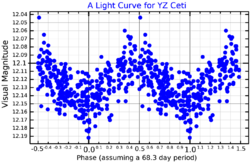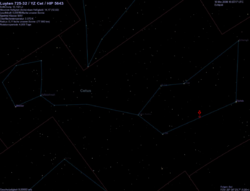Astronomy:YZ Ceti
| Observation data Equinox J2000.0]] (ICRS) | |
|---|---|
| Constellation | Cetus |
| Right ascension | 01h 12m 30.6369s[1] |
| Declination | −16° 59′ 56.358″[1] |
| Apparent magnitude (V) | 12.03 - 12.18[2] |
| Characteristics | |
| Evolutionary stage | red dwarf |
| Spectral type | M4.0Ve[3] |
| U−B color index | +1.430[4] |
| B−V color index | +1.811[4] |
| Variable type | Flare star[5] |
| Astrometry | |
| Radial velocity (Rv) | +28.09[6] km/s |
| Proper motion (μ) | RA: 1,205.074[1] mas/yr Dec.: 637.547[1] mas/yr |
| Parallax (π) | 269.0573 ± 0.0337[1] mas |
| Distance | 12.122 ± 0.002 ly (3.7167 ± 0.0005 pc) |
| Absolute magnitude (MV) | 14.30[3] |
| Details | |
| Mass | 0.130±0.013[7] M☉ |
| Radius | 0.168±0.009[7] R☉ |
| Luminosity | 0.002195[8] L☉ |
| Surface gravity (log g) | 5.20[8] cgs |
| Temperature | 3056±60[7] K |
| Metallicity [Fe/H] | −0.26±0.08[7] dex |
| Rotation | 68.3 d[9] |
| Rotational velocity (v sin i) | 3.40[10] km/s |
| Age | 5.0±1.0[7] Gyr |
| Other designations | |
| Database references | |
| SIMBAD | data |
YZ Ceti is a red dwarf star in the constellation Cetus. Although it is relatively close to the Sun at just 12 light years, this star cannot be seen with the naked eye. It is classified as a flare star that undergoes intermittent fluctuations in luminosity. YZ Ceti is about 13 percent the mass of the Sun and 17% of its radius.
This star is unusually close to Tau Ceti, a star of spectral class G8. The two are only about 1.6 light years apart,[11] a little more than a third of the distance from the Sun to the Solar System's nearest neighbor, Proxima Centauri.
Variability

YZ Ceti is a variable star designation: the star shows occasional rapid and brief increases in brightness, sometimes reaching magnitude 12.03, caused by eruptions from the surface. This type of variable star is known as a UV Ceti star after its first member, or more colloquially as a flare star.
YZ Ceti also shows small periodic variations in brightness caused by starspots or chromospheric features moving as the star rotates. This class of variable stars are known as BY Draconis variables.[2] The periodic variations allow the rotational period of the star to be measured at 68.3 days, although modelling of its planetary system gives a rotational period for the star of 83 days.[9]
Planetary system
On 10 August 2017 three planets were announced to have been discovered around YZ Ceti and a possible fourth sub-Earth planet candidate, still needing confirmation, with 0.472±0.096 Earth masses at an orbital period of 1.04 days. The orbits of the three confirmed planets were determined to be too close to YZ Ceti to be within the star's habitable zone, with equilibrium temperatures ranging from 347–491 K (74–218 °C; 165–424 °F), 299–423 K (26–150 °C; 79–302 °F), and 260–368 K (−13–95 °C; 8–203 °F) for planets b, c, and d, respectively.[7]
An August 2018 study reexamined the discovery measurements, confirming the orbit of YZ Ceti d, but finding a possibly marginally longer orbital period of YZ Ceti b of 2.02 days rather than 1.97 days, and additionally finding that YZ Ceti c probably orbits in only 0.75 days rather than 3.06 days. If the latter is true, YZ Ceti c would have a mass of only 0.58 Earth masses and a roughly 10% chance of transiting YZ Ceti.[12] However, a 2020 study did not support the latter conclusion, finding the 0.75-day period to be an alias of the true 3.06-day period. It also did not find evidence for the fourth candidate planet.[13]
Two 2023 studies detected bursts of radiation in radio wavelengths from YZ Ceti, which is likely associated with interaction of the innermost planet, YZ Ceti b, with the star as well as evidence for the presence of magnetic fields. It may be the first detection of a magnetic field generated by a terrestrial exoplanet.[14][15][16][17]
| Companion (in order from star) |
Mass | Semimajor axis (AU) |
Orbital period (days) |
Eccentricity | Inclination | Radius |
|---|---|---|---|---|---|---|
| b | ≥0.70+0.09 −0.08 M⊕ |
0.01634+0.00035−0.00041 | 2.02087+0.00007−0.00009 | 0.06+0.06 −0.04 |
— | — |
| c | ≥1.14+0.11 −0.10 M⊕ |
0.02156+0.00046−0.00054 | 3.05989+0.00010−0.00010 | 0.00 | — | — |
| d | ≥1.09+0.12 −0.12 M⊕ |
0.02851+0.00061−0.00071 | 4.65626+0.00028−0.00029 | 0.07+0.04 −0.05 |
— | — |
See also
- List of nearest stars and brown dwarfs
- Tau Boötis b another extra solar planet with evidence of magnetic fields
- HAT-P-11b another extra solar planet with evidence of magnetic fields
- HD 209458 b another extra solar planet with evidence of magnetic fields
References
- ↑ 1.0 1.1 1.2 1.3 1.4 Vallenari, A. et al. (2022). "Gaia Data Release 3. Summary of the content and survey properties". Astronomy & Astrophysics. doi:10.1051/0004-6361/202243940 Gaia DR3 record for this source at VizieR.
- ↑ 2.0 2.1 Watson, C. L. (2006). "The International Variable Star Index (VSX)". The Society for Astronomical Sciences 25th Annual Symposium on Telescope Science. Held May 23–25 25: 47. Bibcode: 2006SASS...25...47W.
- ↑ 3.0 3.1 Davison, Cassy L; White, R. J; Henry, T. J; Riedel, A. R; Jao, W.-C; Bailey, J. I; Quinn, S. N; Cantrell, J. R et al. (2015). "A 3D Search for Companions to 12 Nearby M Dwarfs". The Astronomical Journal 149 (3): 106. doi:10.1088/0004-6256/149/3/106. Bibcode: 2015AJ....149..106D.
- ↑ 4.0 4.1 Koen, C; Kilkenny, D; Van Wyk, F; Marang, F (2010). "UBV(RI)C JHK observations of Hipparcos-selected nearby stars". Monthly Notices of the Royal Astronomical Society 403 (4): 1949. doi:10.1111/j.1365-2966.2009.16182.x. Bibcode: 2010MNRAS.403.1949K.
- ↑ Samus, N. N. et al. (2009). "VizieR Online Data Catalog: General Catalogue of Variable Stars (Samus+ 2007-2013)". VizieR On-line Data Catalog: B/GCVS. Originally Published in: 2009yCat....102025S 1. Bibcode: 2009yCat....102025S.
- ↑ Nidever, David L; Marcy, Geoffrey W; Butler, R. Paul; Fischer, Debra A; Vogt, Steven S (2002). "Radial Velocities for 889 Late-Type Stars". The Astrophysical Journal Supplement Series 141 (2): 503–522. doi:10.1086/340570. Bibcode: 2002ApJS..141..503N.
- ↑ 7.0 7.1 7.2 7.3 7.4 7.5 Astudillo-Defru, Nicola; Díaz, Rodrigo F.; Bonfils, Xavier; Almenara, José M.; Delisle, Jean-Baptiste; Bouchy, François; Delfosse, Xavier; Forveille, Thierry et al. (2017). "The HARPS search for southern extra-solar planets. XLII. A system of Earth-mass planets around the nearby M dwarf YZ Ceti". Astronomy & Astrophysics 605: L11. doi:10.1051/0004-6361/201731581. Bibcode: 2017A&A...605L..11A.
- ↑ 8.0 8.1 Schweitzer, A. et al. (May 2019). "The CARMENES search for exoplanets around M dwarfs. Different roads to radii and masses of the target stars". Astronomy & Astrophysics 625: 16. doi:10.1051/0004-6361/201834965. A68. Bibcode: 2019A&A...625A..68S.
- ↑ 9.0 9.1 9.2 Jayasinghe, T; Stanek, K. Z; Kochanek, C. S; Holoien, T. W.-S; Shields, J. V; Thompson, T. A; Shappee, B. J; Prieto, J. L et al. (2017). "ASAS-SN V-band Light Curve of Multi-Planet M-dwarf Host YZ Cet Reveals a Rotation Period of 68 Days". The Astronomer's Telegram 0643: 1. Bibcode: 2017ATel10643....1J.
- ↑ Fouqué, Pascal et al. (April 2018). "SPIRou Input Catalogue: global properties of 440 M dwarfs observed with ESPaDOnS at CFHT". Monthly Notices of the Royal Astronomical Society 475 (2): 1960–1986. doi:10.1093/mnras/stx3246. Bibcode: 2018MNRAS.475.1960F.
- ↑ Page of Tau Ceti, see the chapter of Closest Neighbors, for YZ Ceti.
- ↑ Robertson, Paul (2018). "Aliasing in the Radial Velocities of YZ Ceti: An Ultra-short Period for YZ Ceti c?". The Astrophysical Journal 864 (2): L28. doi:10.3847/2041-8213/aadc0b. Bibcode: 2018ApJ...864L..28R.
- ↑ 13.0 13.1 Stock, S. et al. (2020). "The CARMENES search for exoplanets around M dwarfs". Astronomy & Astrophysics 636: A119. doi:10.1051/0004-6361/201936732. Bibcode: 2020A&A...636A.119S.
- ↑ Pineda, J. Sebastian; Villadsen, Jackie (April 2023). "Coherent radio bursts from known M-dwarf planet host YZ Ceti". Nature Astronomy 7 (5): 569–578. doi:10.1038/s41550-023-01914-0. Bibcode: 2023NatAs...7..569P.
- ↑ "Star-Planet Interaction at radio wavelengths in YZ Ceti: Inferring planetary magnetic field". May 2023. arXiv:2305.00809 [astro-ph.EP].
- ↑ "A magnetic field on a nearby Earth-sized exoplanet?" (in en-US). 2023-04-10. https://earthsky.org/space/magnetic-field-exoplanets-yz-ceti-b/.
- ↑ O'Callaghan, Jonathan (7 August 2023). "Exoplanets Could Help Us Learn How Planets Make Magnetism". https://www.quantamagazine.org/exoplanets-could-help-us-learn-how-planets-make-magnetism-20230807/.
External links
 |




